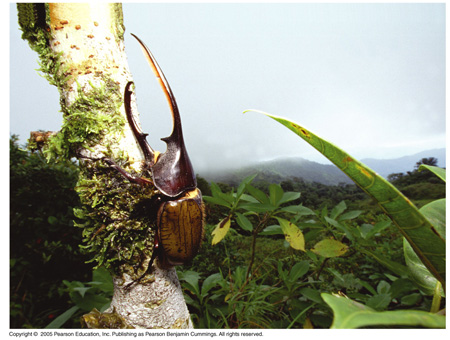FIVE: Ecology
Campbell Chapters 52,53,54,55, and 56
Topic 5: Ecology
For Your Information:![]() Aquatic Biomes
Aquatic Biomes![]() Terrestrial Biomes
Terrestrial Biomes![]() The Nitrogen Cycle
The Nitrogen Cycle
5.1 Communities and Ecosystems—Campbell chapters 52, 53, 54 and 55.
Assessment Statements
• Define species, habitat, population, community, ecosystem and ecology. (5.1.1)
• Distinguish between autotroph and heterotroph. (5.1.2)
• Distinguish between consumers, detritivores and saprotrophs. (5.1.3)
• Describe what is meant by a food chain, giving three examples, each with at least three linkages (four organisms). (5.1.4)
• Describe what is meant by a food web. (5.1.5)
• Define trophic level. (5.1.6)
• Deduce the trophic level of organisms in a food chain and a food web. (5.1.7)
• Construct a food web containing up to 10 organisms, using appropriate information. (5.1.8)
• State that light is the initial energy source for almost all communities. (5.1.9)
• State that energy transformations are never 100% efficient. (5.1.10)
• Explain reasons for the shape of pyramids of energy. (5.1.11)
• Explain that energy enters and leaves ecosystems, but nutrients must be recycled. (5.1.12)
• State that saprotrophic bacteria and fungi (decomposers) recycle nutrients. (5.1.13)

Chapter 52 Presentation-An Introduction to Ecology and the Biosphere
5.1 Communities and Ecosystems—Campbell chapters 52, 53, 54 and 55.
Assessment Statements
• Define species, habitat, population, community, ecosystem and ecology. (5.1.1)
• Distinguish between autotroph and heterotroph. (5.1.2)
• Distinguish between consumers, detritivores and saprotrophs. (5.1.3)
• Describe what is meant by a food chain, giving three examples, each with at least three linkages (four organisms). (5.1.4)
• Describe what is meant by a food web. (5.1.5)
• Define trophic level. (5.1.6)
• Deduce the trophic level of organisms in a food chain and a food web. (5.1.7)
• Construct a food web containing up to 10 organisms, using appropriate information. (5.1.8)
• State that light is the initial energy source for almost all communities. (5.1.9)
• State that energy transformations are never 100% efficient. (5.1.10)
• Explain reasons for the shape of pyramids of energy. (5.1.11)
• Explain that energy enters and leaves ecosystems, but nutrients must be recycled. (5.1.12)
• State that saprotrophic bacteria and fungi (decomposers) recycle nutrients. (5.1.13)
5.3 Populations—Campbell chapter 53.
Assessment Statements
• Outline how population size is affected by natality, immigration, mortality and emigration. (5.3.1)
• Draw and label a graph showing a sigmoid (S-shaped) population growth curve. (5.3.2)
• Explain the reasons for the exponential growth phase, the plateau phase and the transitional phase between these two phases. (5.3.3)
• List three factors that set limits to population increase. (5.3.4)

Chapter 53 Presentation-Population Ecology
5.1 Communities and Ecosystems—Campbell chapters 52, 53, 54 and 55.
Assessment Statements
• Define species, habitat, population, community, ecosystem and ecology. (5.1.1)
• Distinguish between autotroph and heterotroph. (5.1.2)
• Distinguish between consumers, detritivores and saprotrophs. (5.1.3)
• Describe what is meant by a food chain, giving three examples, each with at least three linkages (four organisms). (5.1.4)
• Describe what is meant by a food web. (5.1.5)
• Define trophic level. (5.1.6)
• Deduce the trophic level of organisms in a food chain and a food web. (5.1.7)
• Construct a food web containing up to 10 organisms, using appropriate information. (5.1.8)
• State that light is the initial energy source for almost all communities. (5.1.9)
• State that energy transformations are never 100% efficient. (5.1.10)
• Explain reasons for the shape of pyramids of energy. (5.1.11)
• Explain that energy enters and leaves ecosystems, but nutrients must be recycled. (5.1.12)
• State that saprotrophic bacteria and fungi (decomposers) recycle nutrients. (5.1.13)

Chapter 54 Presentation-Community Ecology
5.1 Communities and Ecosystems—Campbell chapters 52, 53, 54 and 55.
Assessment Statements
• Define species, habitat, population, community, ecosystem and ecology. (5.1.1)
• Distinguish between autotroph and heterotroph. (5.1.2)
• Distinguish between consumers, detritivores and saprotrophs. (5.1.3)
• Describe what is meant by a food chain, giving three examples, each with at least three linkages (four organisms). (5.1.4)
• Describe what is meant by a food web. (5.1.5)
• Define trophic level. (5.1.6)
• Deduce the trophic level of organisms in a food chain and a food web. (5.1.7)
• Construct a food web containing up to 10 organisms, using appropriate information. (5.1.8)
• State that light is the initial energy source for almost all communities. (5.1.9)
• State that energy transformations are never 100% efficient. (5.1.10)
• Explain reasons for the shape of pyramids of energy. (5.1.11)
• Explain that energy enters and leaves ecosystems, but nutrients must be recycled. (5.1.12)
• State that saprotrophic bacteria and fungi (decomposers) recycle nutrients. (5.1.13)
5.2 The Greenhouse Effect—Campbell chapter 55.
Assessment Statements
• Draw and label a diagram of the carbon cycle to show the processes involved. (5.2.1)
• Analyse the changes in concentration of atmospheric carbon dioxide using historical records. (5.2.2)
• Explain the relationship between rises in concentrations of atmospheric carbon dioxide, methane and oxides of nitrogen and the enhanced greenhouse effect. (5.2.3)
• Outline the precautionary principle. (5.2.4)
• Evaluate the precautionary principle as a justification for strong action in response to the threats posed by the enhanced greenhouse effect. (5.2.5)
• Outline the consequences of a global temperature rise on arctic ecosystems. (5.2.6)


